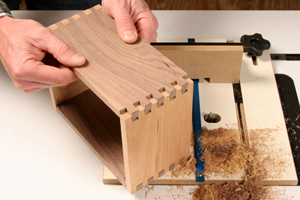
I’m still fairly new to woodworking and just started using box joints for some of my projects. I do not have a very good dado blade and I was wondering how to make accurate box ends without a dado.
Michael Dresdner: Got a router in a table? It is even easier. Buy a 1/2″ straight bit, cut two 1/2″ strips of wood on your saw, and affix one to the table or a jig on the table 1/2″ away from the path of the bit. Use the strip as a fence to cut the first pass through the side. That will give you a 1/2″ notch set 1/2″ from the edge. Now straddle the strip fence with the freshly cut notch and make a second pass. That will give you another 1/2″ notch 1/2″ from the last one. Step it over each time until you run out of side.
To do the mating part, add your extra strip as a shim for the first pass so that you start with a negative space instead of a positive one. If it is all set up accurately, the parts should mate nicely, and you can do it all with just one bit and one jig. Naturally, for it to come out even the piece will have to be a multiple of 1/2″, or you will need to modify the end cuts. For larger box joint fingers, use a 3/4″ bit with a 3/4″ fence, or even a 1/4″ for smaller ones.
Ellis Walentine: Well, short of getting an Incra or Jointech jig, you might be interested in using a regular saw blade to make your box joints. The jig is the same. Make a box joint attachment for your miter gauge by kerfing an accurately dimensioned piece of hardwood or plywood, gluing a tab of wood in the kerf as an index pin, and screwing the rig onto your miter gauge so that the pin is exactly one blade width from the blade itself. My hunch, though, is that if your dado set can cut a groove, it’s good enough for box joints, unless the groove isn’t square.





